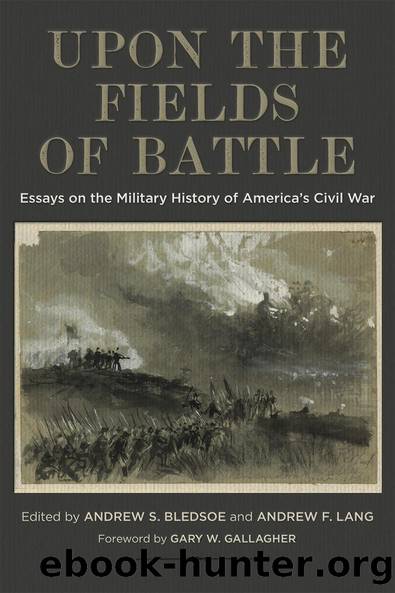Upon the Fields of Battle by Andrew S. Bledsoe Andrew F. Lang

Author:Andrew S. Bledsoe, Andrew F. Lang [Andrew S. Bledsoe, Andrew F. Lang]
Language: eng
Format: epub
Tags: Classics, Kids, Teen, Fiction, General Fiction
ISBN: 9780807169773
Goodreads: 38799763
Publisher: LSU Press
Published: 2018-11-07T00:00:00+00:00
NOTES
1. A note on source material: This essay is based almost entirely on sources written during or soon after the event. In reviewing items written after the war, it quickly became apparent that writers often minimized or even dismissed the events that were so plainly and vividly described in 1862. Indeed, the contrast between wartime and postwar sources relating to the looting and bombardment of Fredericksburg would itself make an excellent case study in the evolution of memory and forgetting.
2. âThe Fredericksburg Disasterââa letter from âJ.F.â [of the Irish Brigade],â Dec. 23, 1862, Irish American Weekly, Jan. 17, 1863.
3. âThe Progress of the Decisive Campaign,â Philadelphia Inquirer, Dec. 16, 1862; Letter of âW.S.W.â [Lt. William S. Walton, 34th New York], Herkimer (NY) County Journal, Dec. 25, 1862.
4. Two outstanding analytical narratives of the Battle of Fredericksburg are George C. Rable, Fredericksburg! Fredericksburg! (Chapel Hill: University of North Carolina Press, 2002); and Francis AugustÃn OâReilly, The Fredericksburg Campaign: Winter War on the Rappahannock (Baton Rouge: Louisiana State University Press, 2003).
5. The most obvious case study of a general caught in the crosswinds of a changing war is George B. McClellan, and the most balanced work on this topic is Ethan Rafuse, McClellanâs War: The Failure of Moderation in the Struggle for the Union (Bloomington: Indiana University Press, 2005).
6. âThe Army of the Rappahannock (From Our Own Correspondent),â Richmond Examiner, Dec. 18, 1862. The Examinerâs correspondent in the town was former resident James B. Sener, a part owner of the Democratic Recorder, who relocated to Richmond when war forced Fredericksburgâs local papers out of print. Senerâs dispatches from Fredericksburg to the Examiner in late 1862 and into 1863 are outstanding and underutilized sources for life in that war-torn town.
7. For McDowellâs strength at Fredericksburg, see Irvin McDowell to his wife, June 15, 1862, McDowell Letters, Fredericksburg and Spotsylvania National Military Park (hereafter referred to as FSNMP), copy.
8. The general order governing foraging, dated May 7, 1862, appears in âMcDowell Court of Inquiry,â U.S. War Department, The War of the Rebellion: A Compilation of the Official Records of the Union and Confederate Armies, 70 vols. in 128 pts. (Washington, D.C.: Government Printing Office, 1880â1901), ser. 1, 12(1):51 [hereafter cited as OR, all items from ser. 1]. Haupt testified to the requirement to leave sufficient supplies for the subsistence of the affected family. Ibid., 77. See also Davis Tillsonâs testimony, ibid., 80. For an expression of support for McDowellâs practices in the field, see âThe Intent and Spirit of the War,â Springfield (MA) Republican, May 21, 1862.
9. Letter of âCâ (20th New York State Militia), Apr. 29, 1862, Kingston (NY) Argus, May 7, 1862. Edmund Schriver, McDowellâs chief of staff, testified to the rebuilding of Lacyâs fences. OR, 12(1):105. See also unattributed correspondence, Philadelphia Sunday Dispatch, Jan.18, 1863.
10. In late 1862 the governmentâat McDowellâs requestâconvened a court of inquiry to examine the generalâs acts in the field. The proceedings of that court include a trove of material reflecting on the armyâs interactions with civilians in and around Fredericksburg.
Download
This site does not store any files on its server. We only index and link to content provided by other sites. Please contact the content providers to delete copyright contents if any and email us, we'll remove relevant links or contents immediately.
In Cold Blood by Truman Capote(3311)
The Innovators: How a Group of Hackers, Geniuses, and Geeks Created the Digital Revolution by Walter Isaacson(2846)
Steve Jobs by Walter Isaacson(2836)
All the President's Men by Carl Bernstein & Bob Woodward(2328)
Lonely Planet New York City by Lonely Planet(2172)
And the Band Played On by Randy Shilts(2131)
The Room Where It Happened by John Bolton;(2104)
The Poisoner's Handbook by Deborah Blum(2093)
The Murder of Marilyn Monroe by Jay Margolis(2059)
The Innovators by Walter Isaacson(2056)
Lincoln by David Herbert Donald(1945)
A Colony in a Nation by Chris Hayes(1881)
Under the Banner of Heaven: A Story of Violent Faith by Jon Krakauer(1750)
Amelia Earhart by Doris L. Rich(1650)
The Unsettlers by Mark Sundeen(1647)
Being George Washington by Beck Glenn(1623)
Birdmen by Lawrence Goldstone(1621)
Dirt by Bill Buford(1612)
Zeitoun by Dave Eggers(1593)
